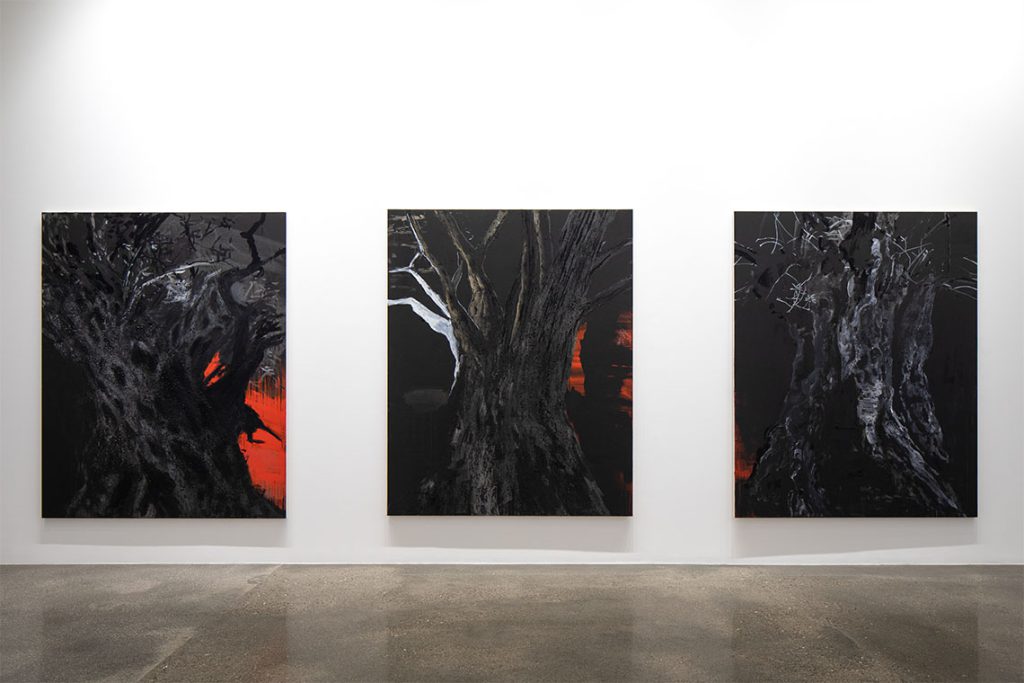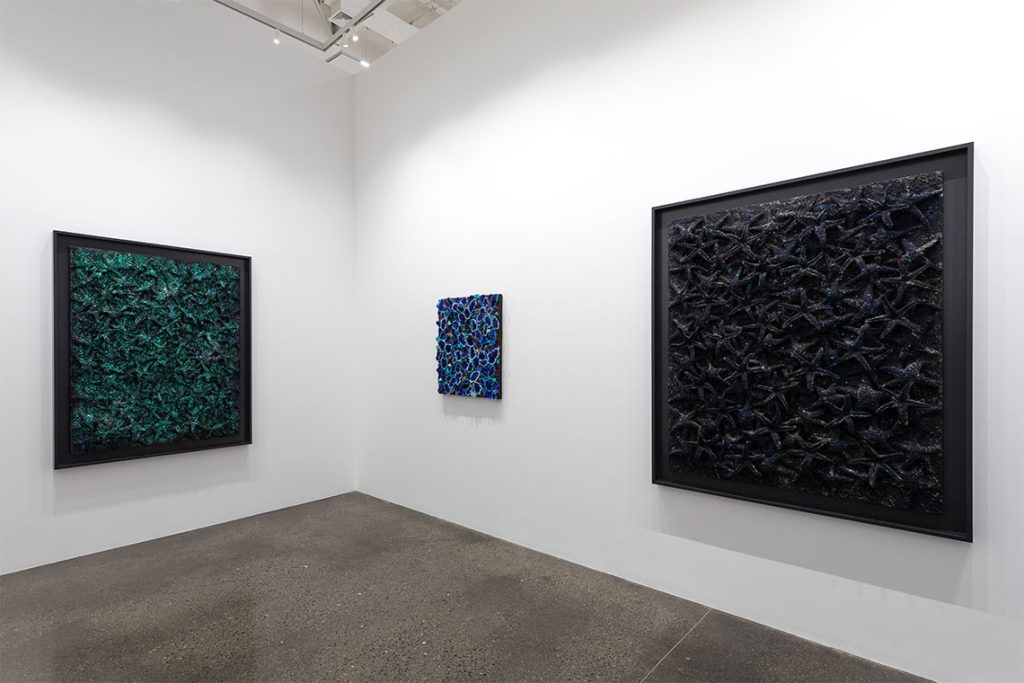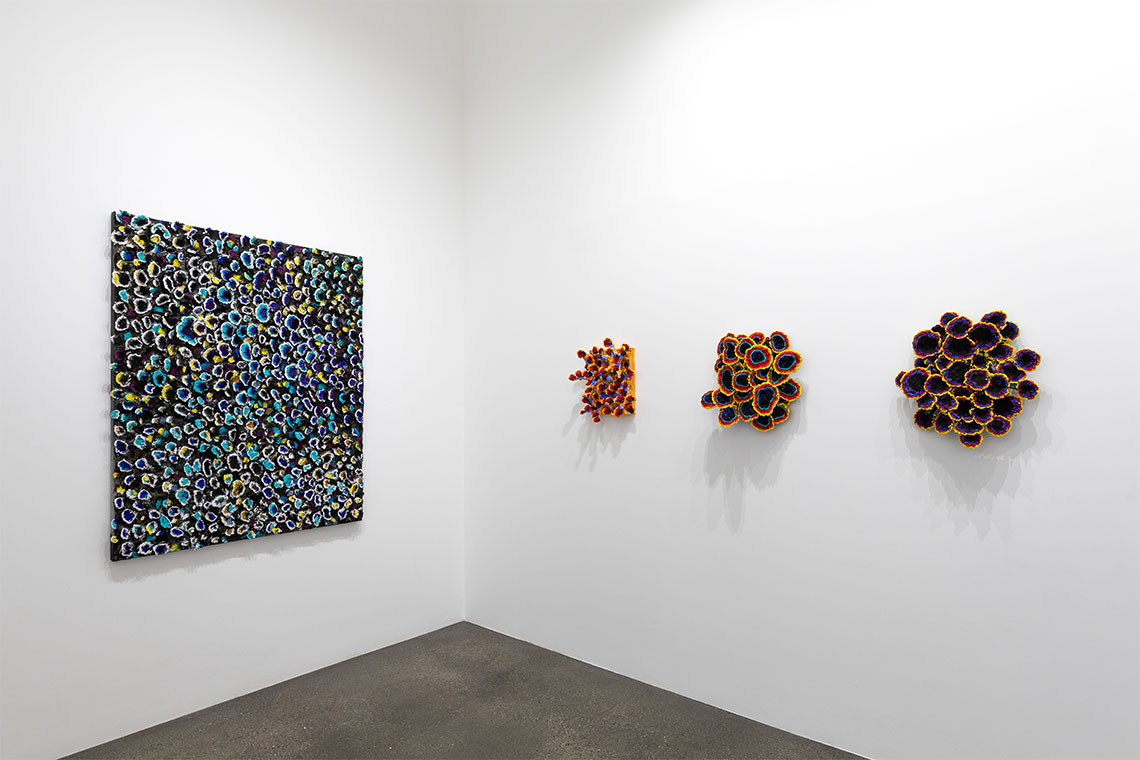Tethys, the solo show by Nabil Nahas at Lawrie Shabibi, sees a retreat into nature in the face of challenging realities.
Bursts of colour and a personal fusion of geometry and nature characterise the oeuvre of Lebanese-American artist, Nabil Nahas, who has returned to Lawrie Shabibi for his solo exhibition, Tethys. Born in 1949 in Beirut, the artist’s youth was divided between Egypt and Lebanon before he left to study in the USA. A graduate of Yale’s Fine Art program, he was a student of American Abstract Expressionist painter, Al Held, whose influence left an imprint on his artistic practice. Situating himself amidst the cultural landscape of 1970s New York, Nahas immersed himself in the artistic milieu of the moment.
The amalgamation of these diverse contexts – the Mediterranean and Manhattan, the exposure to American abstract expressionism, and the natural terrain and Islamic geometry experienced during his early years – converges in Nahas’s output. His art offers us an intimate interpretation of nature and Islamic art, with an emphasis on the interplay between geometric and chromatic qualities.
The artist’s refusal to confine himself to a singular style is evident as one enters the exhibition space. Inside, ‘untitled’ pieces span two rooms yet each domain encloses conceptually and technically disparate bodies of work. In the main room, ten large-scale acrylic-on-canvas paintings from Nahas’s Landscapes series (2022-23) dominate the walls. Despite their title, these paintings are more than landscapes; they are expressive portraits with Lebanon’s emblematic trees – the cedar, the olive and the palm – as their focal points. Trees, frequently harnessed as metaphors, might be read as powerful symbols of life, fertility, territory or resilience and in Nahas’s work, they make visible the fragile line between nature and politics.
Widely considered a universal marker of peace, in the context of Palestine olive trees are regarded as a symbol of national identity and rootedness to the land. Nahas has them doing battle with an invisible storm, while his cedars – Lebanon’s national emblem and commonly associated with strength, wisdom and protection – are blurred, exposing the compromised state of his country’s national icon.

Three monumental works on the back wall display charred branches set against a sombre night sky; the otherwise colourless canvases are illuminated by flashes of crimson that appear as flickers of rage. These ghostly silhouettes are the artist’s visceral response to the August 2020 explosion in the port of Beirut; his anger and grief materialised through gestural strokes that carry the weight of dark memories.
Amidst the Landscapes, some compositions offer contrasting optimism. Palms sway against a crisp blue sky, invoking the chill of winter while the moon serves as a silent witness, connecting humanity to the Earth. Vibrant circular forms in acid greens and yellows hint at infinity or capture fleeting moments of brilliance as light escapes through leaves. These bursts of colour echo the palette of the fractal works displayed in the adjacent room, creating a visual portal that connects the two dimensions of the artist’s psyche.
In a second room, Nahas presents 11 pieces from his evolving Fractal series (2003–ongoing). These jazzy, sculpture-like paintings draw inspiration from marine and biomorphic phenomena and elicit an entirely different emotional response; it’s hard to comprehend that the two bodies of work were produced simultaneously. Here, the artist employs his distinctive ‘encrusted’ technique, layering acrylic paint mixed with pumice stone to construct a three-dimensional surface. This process, akin to “sculpting with paint”, reflects Nahas’s quest to compose a personal visual language. These creations appear energetic, yet their production is prolonged. The works take years to complete as the artist patiently establishes his layers.
Are these fractal works raising concern over the fragility of the natural environment or do they simply speak of the artist’s adoration of the underwater realm? They are narrative in that they stem from the artist’s love of scuba diving. Smaller works summon the ocean’s hues; ultramarine and turquoise illuminated with flickers of light and luminescent tones that capture the experience of gliding through a coral reef.

In contrast to the Landscapes series, the Fractal works offer an opportunity for escapism; a chance to transcend the tribulations of everyday reality. The compositions possess dual scale, appearing both microscopic and macroscopic, inviting viewers to focus on minute details or observe Nahas’s ecosystem of encrusted forms from great height. Two larger rectangular pieces feature a constellation of starfish coated in a mixture of charcoal-hued acrylic and teal glitter atop wooden panels. They materialise a moment of awe as Nahas stumbled upon a starfish-strewn beach on Long Island during the early 1990s. It was at this time that he began to collect and cast natural elements in his practice in a manner that suggests the momentum of Islamic geometry.
One might initially perceive the works in Tethys as the creations of two different artists, prompting contemplation as to why Nahas might have cultivated such varied styles. It is perhaps the artist’s dual affiliation as a Lebanese-American that connects the artistic dots. Tethys reveals distinct emotional landscapes: the energetic and optimistic fractal works exude universal appeal, while in contrast, his landscapes convey the gravity of a specifically Lebanese experience. Together, however, these series speak of his reverence for the natural environment – the all-encompassing force that continues to propel his practice.



